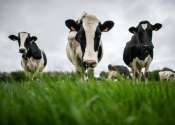Bovine spongiform encephalopathy (BSE), commonly known as mad-cow disease (MCD), is a fatal, neurodegenerative disease in cattle, that causes a spongy degeneration in the brain and spinal cord. BSE has a long incubation period, about 4 years, usually affecting adult cattle at a peak age onset of four to five years, all breeds being equally susceptible. In the United Kingdom, the country worst affected, more than 179,000 cattle have been infected and 4.4 million slaughtered during the eradication programme.
It is believed by most scientists that the disease may be transmitted to human beings who eat the brain or spinal cord of infected carcasses. In humans, it is known as new variant Creutzfeldt-Jakob disease (vCJD or nvCJD), and by February 2009, it had killed 164 people in Britain, and 42 elsewhere with the number expected to rise because of the disease's long incubation period. Between 460,000 and 482,000 BSE-infected animals had entered the human food chain before controls on high-risk offal were introduced in 1989.
A British inquiry into BSE concluded that the epidemic was caused by cattle, who are normally herbivores, being fed the remains of other cattle in the form of meat and bone meal (MBM), which caused the infectious agent to spread. The origin of the disease itself remains unknown. The infectious agent is distinctive for the high temperatures at which it remains viable; this contributed to the spread of the disease in Britain, which had reduced the temperatures used during its rendering process. Another contributory factor was the feeding of infected protein supplements to very young calves.







